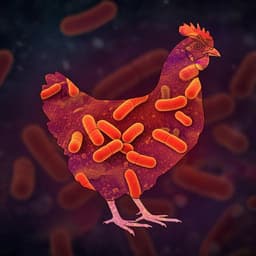
Earth Sciences
Around one third of current Arctic Ocean primary production sustained by rivers and coastal erosion
J. Terhaar, R. Lauerwald, et al.
This study by Jens Terhaar, Ronny Lauerwald, Pierre Regnier, Nicolas Gruber, and Laurent Bopp reveals how land-derived nutrients significantly impact net primary production (NPP) in the Arctic Ocean, accounting for up to 51% of the current NPP due to enhanced nutrient recycling. Discover the factors shaping the future of Arctic ecosystems!
Playback language: English
Introduction
The Arctic Ocean's primary production, driven by phytoplankton, is fundamental to its unique ecosystem. While lateral inputs from adjacent oceans and upwelling are considered major nutrient sources, the contribution of land-derived nutrients via rivers and coastal erosion has been largely underestimated. This is especially significant given the rapid changes occurring in the Arctic due to climate change. Arctic Ocean NPP has increased by 57% between 1998 and 2018, attributed to warming, sea-ice reduction, and altered ocean circulation. Projections of future NPP vary widely among models due to the complex interplay of nutrient and light limitations. While past studies focused on physical conditions, recent research suggests terrigenous nutrient inputs are a critical, yet often neglected, factor. The Arctic Ocean's unique geographical setting—a watershed larger than its ocean area—receiving 11% of global river discharge and experiencing rapid coastal erosion due to thawing permafrost—amplifies the potential impact of terrigenous nutrients. Despite this potential, the magnitude of these fluxes and their impact on NPP remain poorly understood. Prior studies extrapolated nutrient fluxes from the six largest Arctic rivers, estimating riverine-driven NPP at 4–10% of total Arctic NPP, but lacked estimates for coastal erosion. This study aims to address this gap by providing a spatio-temporally resolved estimate of riverine and coastal erosion inputs of carbon and nutrients, and quantitatively assessing their impact on Arctic Ocean NPP.
Literature Review
Previous research on Arctic Ocean primary production (NPP) has primarily focused on the role of lateral inputs from adjacent oceans and upwelling. Studies like those by Arrigo and van Dijken (2015) and Lewis et al. (2020) highlight the significant increase in Arctic NPP in recent decades, primarily attributing it to changes in sea-ice extent and ocean circulation. However, the contribution of terrigenous nutrient inputs from rivers and coastal erosion has been largely neglected in these studies. While some studies (e.g., Holmes et al., 2011; Tank et al., 2012) have examined riverine nutrient fluxes, estimates of their impact on Arctic NPP vary significantly, ranging from 4% to 10% of total Arctic NPP. No previous pan-Arctic estimates existed for nutrient fluxes from coastal erosion and their impact on Arctic NPP. The lack of comprehensive data on nutrient content in eroded soils and the complexity of the land-ocean interaction processes have hindered accurate quantification of these contributions.
Methodology
This study constructed a gridded, seasonally resolved estimate of terrigenous carbon and nutrient inputs to the Arctic Ocean from rivers and coastal erosion. For rivers, monthly fluxes from the six largest Arctic rivers (Mackenzie, Yukon, Kolyma, Lena, Ob, Yenisei) were upscaled to the entire Arctic catchment using a spatially explicit prediction based on watershed characteristics. Multiple linear regression was used, incorporating catchment properties like permafrost extent, lake proportion, and soil composition, to extrapolate annual fluxes to unmonitored river basins. Seasonal variation was estimated using the relationship between river discharge and nutrient fluxes. For coastal erosion, total carbon and nutrient inputs were calculated from spatially resolved erosion rates and estimates of carbon and nutrient content in coastal soils. Stoichiometric ratios were used to convert carbon fluxes to nitrogen and phosphorus fluxes. The derived riverine and coastal erosion fluxes were then used to force the high-resolution (~14 km) ocean-biogeochemical model NEMO-PISCES over 1990-2010. Three simulations were conducted: a baseline simulation (Baseline) including both riverine and coastal erosion inputs; a simulation excluding coastal erosion input (NoCoast); and a simulation excluding all terrigenous inputs (NoTerr). The differences between these simulations were used to quantify the impact of each input. The model simulated dissolved inorganic and organic carbon, alkalinity, oxygen, nitrogen, phosphorus, silica, and iron, along with four living pools (nanophytoplankton, diatoms, microzooplankton, and mesozooplankton). Phytoplankton growth was limited by light and nutrient availability, although shading from particles was not explicitly modeled. All terrigenous organic matter fluxes were added as inorganic forms, acknowledging an overestimation of available nutrients, which was later quantified. The model output from 2005-2010 (after a transient period) was analyzed to assess the impact of terrigenous nutrient inputs on Arctic Ocean NPP. Uncertainties in the nutrient fluxes were assessed by considering the spatial and temporal extrapolation of data, variability in soil nutrient content, and the reactivity of organic matter. Remote sensing-based NPP estimates were used for comparison and validation.
Key Findings
The study estimated that rivers currently deliver 1.0 Tg N yr⁻¹ of dissolved nitrogen to the Arctic Ocean, with 60% from five major rivers (Mackenzie, Pechora, Ob, Yenisei, Lena), predominantly from the Russian Arctic. Coastal erosion contributes an estimated 1.6 Tg N yr⁻¹, almost entirely in particulate form. The spatial distribution of riverine input is highly variable, while coastal erosion input is more homogeneous, with higher rates along the Eurasian coast. Seasonally, riverine input peaks during the spring freshet, while coastal erosion peaks later in the year. The Baseline simulation estimated an average annual NPP of 380 Tg C yr⁻¹ for the defined Arctic Ocean area (2005-2010), in good agreement with remote sensing-based estimates (540 ± 25 Tg C yr⁻¹). The NoTerr simulation showed a 36% reduction in NPP compared to the Baseline, highlighting the importance of terrigenous nutrients. Coastal erosion sustained 21% of NPP, while rivers sustained 15%. The relative contribution of terrigenous nutrients was highest on Siberian shelves (57–80%), where lateral nutrient inputs from adjacent oceans are minimal. Efficient nutrient recycling (approximately seven times per mol of nitrogen) was observed, mainly through remineralization in sediments (52%) and, to a lesser extent, in the water column (26%). The study also found that benthic processes significantly contribute to nutrient cycling in shallow waters. Uncertainty analysis revealed potential overestimation of NPP driven by the assumption of instantaneous remineralization of organic matter, leading to an adjusted range of 28–51% of total Arctic Ocean NPP sustained by terrigenous nitrogen. Considering additional sources of terrigenous nitrogen (riverine particulate nitrogen and subsea erosion) and the organic matter reactivity adjustments further refined the estimate to 28–51% of total Arctic Ocean NPP. This represents a much larger contribution than previously estimated by other studies, with coastal erosion playing a significantly larger role than rivers.
Discussion
The findings of this study significantly advance our understanding of the Arctic Ocean's NPP. The considerable contribution (28–51%) of terrigenous nutrients, especially from coastal erosion, challenges previous assumptions that primarily focused on lateral inputs and upwelling. The efficient recycling of terrigenous nutrients on the extensive Arctic shelves plays a crucial role in sustaining this high NPP. The regional variations in the impact of terrigenous nutrients highlight the importance of considering both geographical context and the balance between terrigenous and lateral inputs in models. The agreement between the simulated and remote-sensing-based NPP, despite model simplifications (e.g., neglecting the effect of terrigenous particulate matter on light availability), strengthens the study's conclusions. However, the significant uncertainties in estimating terrigenous nutrient fluxes, particularly from coastal erosion, warrant further investigation. The study's findings have implications for projecting future Arctic Ocean NPP and fishery resources, as increased riverine discharge and coastal erosion are anticipated under climate change.
Conclusion
This study provides a comprehensive assessment of the contribution of terrigenous nutrients from rivers and coastal erosion to Arctic Ocean NPP, revealing that these sources account for a substantial 28–51% of total productivity. Coastal erosion emerges as a major driver, surpassing riverine inputs in its overall impact. The efficient recycling of these nutrients within the shallow Arctic shelves is crucial for maintaining high productivity levels. These findings necessitate the inclusion of more precise estimates of terrigenous nutrient fluxes in Earth System Models to improve predictions of Arctic Ocean NPP and the associated implications for marine ecosystems and fisheries. Further research should prioritize improving the quantification of terrigenous fluxes, particularly from coastal erosion, and investigating the complex biogeochemical processes at the land-ocean interface.
Limitations
The study acknowledges several limitations. The assumption of instantaneous remineralization of organic nutrients in the model likely overestimates nutrient availability for primary production. The model does not explicitly account for the effect of terrigenous particulate matter on ocean turbidity and light availability for phytoplankton. Additional sources of terrigenous nitrogen (e.g., subsea permafrost erosion, riverine particulate nitrogen) are not fully quantified. The lack of precise uncertainties for previously published observational data makes it challenging to fully quantify the uncertainty range for the estimated fluxes. Despite these limitations, the study's findings provide a significant improvement in our understanding of the role of terrestrial inputs in the Arctic Ocean NPP.
Related Publications
Explore these studies to deepen your understanding of the subject.







